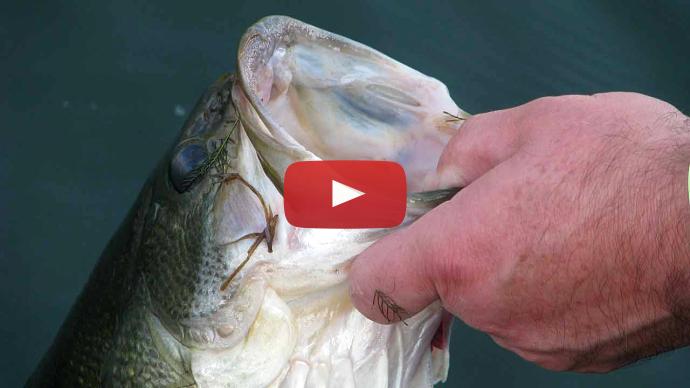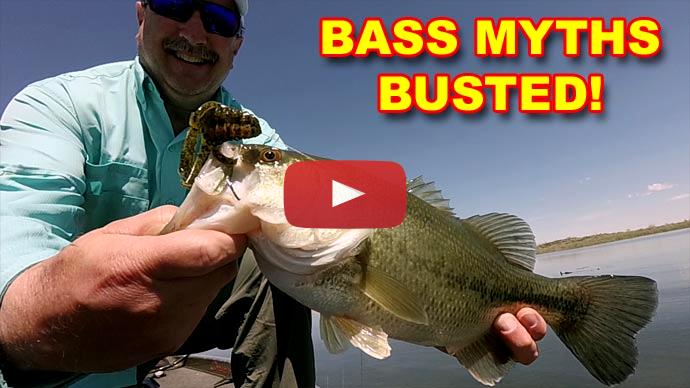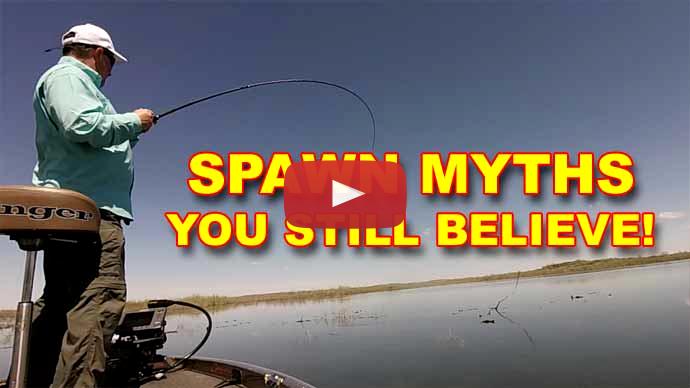Glenn: There I go.
Glenn: Man, these smallmouth fight hard.
Hey folks, Glenn May here with BassResource.com. And today I want to talk about smallmouth bass. You see, smallmouth, they kind of go around here today, gone tomorrow. Sometimes are really hard to catch and other times, you can just throw a paperclip out there and they'll hit it. It seems like they're just kind of an enigma for some people. And for these reasons, some of this information gets passed along from generation to generation and myths become fact and it just adds to the mystery of smallmouth.
So today, I kind of want to clear that up, I want to talk about the seven myths and misconceptions about smallmouth bass. And hopefully that's going to help you catch more smallies. So let's get right into it.
The first one I'd like to talk about is in the summertime, if you want to catch a big smallie, you have to fish deep. That's just all there is to it. Well, not exactly true. You know, as with any myth or misunderstanding, there's a little bit of truth into it to give a little bit of credibility. And it is true, in the summertime that a lot of fish do go deep. And so you do catch a lot of fish going offshore, catch a little bit of deeper structure humps, you know, deeper creek channels, things like that.
That is true. However, it's not always true. And the thing about smallies, especially big ones, what I found is during the summertime when you get those really hot days, when the sun is overhead like a bright bluebird day like we have today and it's calm, flat, calm. Look at this, you know the water back here, flat, calm. Days like this, that's what a lot of big smallies come up shallow to feed and you can catch a lot of big ones fishing shallow.
And you know, it seems counterintuitive. A lot of guys when they see these conditions, they immediately go out fish deep and they don't catch as many big ones. And so just pay attention to these conditions. Nice summer days, calm conditions, bright sunny days.
For some reason those big smallies come up shallow. I don't exactly know why I just know that it's pretty consistent. So don't always fish deep in the summertime if you want to catch big smallies.
Now the next misconception I want to talk about, largemouth like weeds, smallmouth like rocks. That's all there is to it. Well, you know, you do tend to catch a lot of smallies in rocky areas. However, that doesn't mean they don't use weeds, particularly in the warmer months, say from mid spring to mid fall. When the grass and the weeds are growing really, they're nice and healthy, they're making a lot of oxygen and there's a lot of cover available. Man, that brings in the insects, the invertebrates, the baitfish are in there. And wherever that is, whereever the food source is, well, that's where you're gonna find the smallies.
However, I think where this misconception comes from is because largemouth tend to use weed beds different than smallies. With largemouth, you're out there fishing the big expanses, right? The big flats. You're throwing lures over the top of the weeds and the bass are busting up through it and by and large, those are largemouth. Smallmouth on the other hand, they tend to cruise the outer edges of these weed beds, flushing out baitfish chasing them down waiting for ambush, that sort of thing. What happens is a lot of people are out there catching largemouth fishing these big weed expanses and they think, "Okay, smallmouth don't use them." Guys, if you want to catch big smallies in the weeds, concentrate on those outer edges and I promise you, you're gonna find some smallies.
There we go.
Keri: Oh, you got it.
Glenn: That's a good one. That's a good one. Oh, boy. There we go, there we go.
Keri: That's a fighter guy too.
Glenn: Yeah he is. Smallmouths don't give up. There we go. Here we go.
Keri: That's a little better fish, he's been speared by something.
Glenn: Probably a Cormorant That was a decent fish.
Keri: Yeah
Glenn: We'll take it. On a reaper. All right, buddy. These guys love to fight. I'll let you go.
Alright, next misconception. That is that smallmouth, they tend to move around a lot, right? They're nomadic, they're here today gone tomorrow, they're hard to find. It's in their nature.
Well, from an angler's perspective, I think trying to understand why bass seemed to move around a lot, it may seem like the sensible conclusion that it's in their nature, in their DNA for bass to move around a lot.
It's not per se, it's really about where the baitfish are. As the baitfish move around, so too will the bass. If you've got a lake that's got a lot of baitfish in it, that move around a lot, they're gonna tow those smallie everywhere.
The smallies are very aggressive and they're going to be on it, they're not going to wait for another pod of baitfish to come by, or a school of baitfish to come by. They're gonna chase them down.
So it depends on the forage on your lake. For example, if your lake or river has a lot of trout in it, has a lot of perch in it, or blueback herring, that sort of thing where they move around a lot, then the smallmouth are going to be towed all over that lake for chasing them down. So that's why you can be in the thick and suddenly they're gone. Like what happened? Well, the smallmouth didn't move because it's in their DNA to move, they moved because the baitfish moved.
Now, if you're in a lake that doesn't have that kind of forage, say it's got a lot of gobies in it. Well, gobies don't tend to move around much and they don't move very fast. So the smallies can build a house and little summer cabin, you know, the white picket fence and set up on the porch drinking sweet tea waiting, you know, just feeding on those gobies all day long, right? They're not going to move very much, they're going to stay in place.
So it's all about the forage guys, not so much the DNA or nature of the bass of the smallies themselves. So learn about the forage base in your body of water and the characteristics of bait fish around and you're going to locate those smallies a lot easier.
Alright, next misconception. Finesse tactics are the way to go to catch smallmouth. Okay, this is an interesting one. So yes, finesse tactics do work on smallies, they also work on largemouth as well. The thing is, though, by nature, if you're going to compare all things being equal, a smallmouth to a largemouth, a smallmouth is more aggressive. Whether it's a real aggressive day where they're feeding heavily, or it's, you know, post front conditions where they have lockjaw, even when they're not biting very much and the bite is off, the smallmouth still are a little more aggressive than the largemouth.
So with that in mind, typically when the bite is off, and the bite is slow, you're using slow presentations and small lures, such as you would with finesse tactics.
So you have a larger chance or a higher probability of catching a smallmouth under those conditions than a largemouth because the smallmouth are still more aggressive than largemouth.
The bite still going to be off, you're still not going to catch a whole lot and you still got a fish methodically and really slow. But if all things being equal, you'll end up catching more smallies and largemouths if they're both in the same body of water.
So it's not that finesse tactics catch more smallmouth, it's just that smallmouth are more aggressive under the conditions when you would use finesse tactics. I think, yeah, I hope that makes sense.
Okay, there we go. There's a good smallie. Just get him in, come on. These guys just don't give up, do they? They do not give up. Come here. There we go. That's what a reaper can do for you. Nice smallie, that works.
Alright, let's get to the next misconception. And that is hair jigs are old school, they don't work as well because there's other lures available out there that work better.
Well, yeah and no. Yes, with the advent of plastics and soft plastic baits, there are a lot of really good lures out there that work under the same conditions where hair jigs work well.
Hair jigs have been around for decades. I've been fishing them for a long time, long time. And they're proven in and out year after year. They catch bass, they always do. And that's why they're still productive today. You can still catch bass on them.
The thing is hair jigs, for me, excel when the water is cold. During those late fall all the way to early, early spring when the water is at its coldest. For me, hair jigs will outperform any plastic two to one. That's just, you know, you catch a lot more. The hair jigs work a lot better under colder conditions.
That's not to say that soft plastic baits and other lures don't work, jigging spoons, things like that, when it's cold. They do and they have their place in your arsenal. But too many people don't fish hair jigs in the wintertime, when you should, you're going to catch a lot more smallies that way.
Now, the problem that I see is a lot of anglers after the water starts to warm up, they put away their hair jigs for the season, they don't break him out again until winter. And that's a big mistake. Hair jigs work really well throughout the year, particularly when the bite is really off or when the fish are out suspended. When conditions are such that the bite is really slow, and you're going to finesse tactics, hair jigs can really excel under these conditions. Like middle of summer, for example, that can happen and you get a big front that comes through and shuts them down. Finesse tactics work well and you can catch fish that way but guys, don't be afraid to break out a hair jig during this time. I have and sometimes it outperforms the soft plastics and the finesse tactics, even in the middle of summer.
Now for me, it doesn't matter whether it's a bucktail jig or whether it's marabou jig, you know, the hair to me, I catch them equally. Some guys are real adamant about one kind or the other and that's fine if you're like that. I'm just saying if you're not fishing hair jigs you should and keep them ready year round because you might be surprised how many smallmouth you can catch with them.
Alright, then the next misconception is that to catch smallies, your lure colors need to be bright and flashy, like red and chartreuse. Yeah, well, sometimes smallies really do like those colors. And that's true, that does happen. But by and large, I fish smallies all around the country. And if I'm fishing hard baits I stick to the natural colors, usually ones that resemble closely the bait fish, you know, the forage in the lake.
So your shad colors, your perch colors, right? Your bluegill colors, things like that. You want it to look normal and natural, that's what the bass are feeding on. So I stick to those colors. Typically also, smallmouth waters are a little bit clear too, so natural colors are the norm.
As for plastics, green pumpkin reigns supreme. You know, it's a very popular color for a reason, it works. It really does. And throughout the whole country, when I'm throwing in like a tube or jig, I'm throwing a little grub, whatever it be, a green pumpkin, day in and day out produces overwhelmingly more than other colors.
Now, that's not to say I don't use the flashy colors, I do as an accent. Like I might dip a tail and chartreuse or I might have a you know, a sexy shad for crankbait has a stripe of chartreuse in their little flash, I tend to go a little bit more towards the brighter colors in the fall. Like those fire tiger patterns tend to work really well in the fall when they're really feeding up on baitfish getting ready for winter. But mostly, you know, you want to talk year round and day in and day out. Those natural colors and green pumpkin colors are the ones I'm going to reach for the most.
Alright, next misconception. And I hear this a lot, guys. I hear this every year and I keep trying to dispel this one but I keep hearing it. And that is, the best time to catch a big smallie is during the spawn.
I can see where this one comes from. When you're out there fishing the beds and you have to fishing shallow during the spawn, that's when the majority of fish are up shallow and you can see them. So you tend to see that more of the larger smallmouth that are out there roaming around. But it's not the best time to catch the biggest smallie, in my opinion.
Because you see, these fish when they're spawning man, that's what they got in mind is the spawn, they're not eating. They're expelling energy, they're using up their energy reserves. So they're losing weight, and they're laying eggs and they're losing more weight and they're certainly not feeding so they're harder to catch.
Really, the best time if you want to catch yourself a big smallie, in my opinion, the best time to do it is late winter in early spring. You guys up north know this when the ice out just occurs, that's usually the best time to catch those big smallies,man. They're full of eggs, they've been feeding during the winter time. They're just starting to feed now heavily to accelerate their feeding schedule for the spawn. And that is really the best time. You want to catch a trophy smallie? Late winter, early spring, that's the time to target them.
Alright, so those are the top myths about smallmouth. I hope that helps you catch a lot more. For more tips and tricks like this, visit BassResource.com.



